11 Common Hair Problems And How To Fix Them
Be it frizzy hair, dandruff or split ends, these simple hacks are the answers to them all!
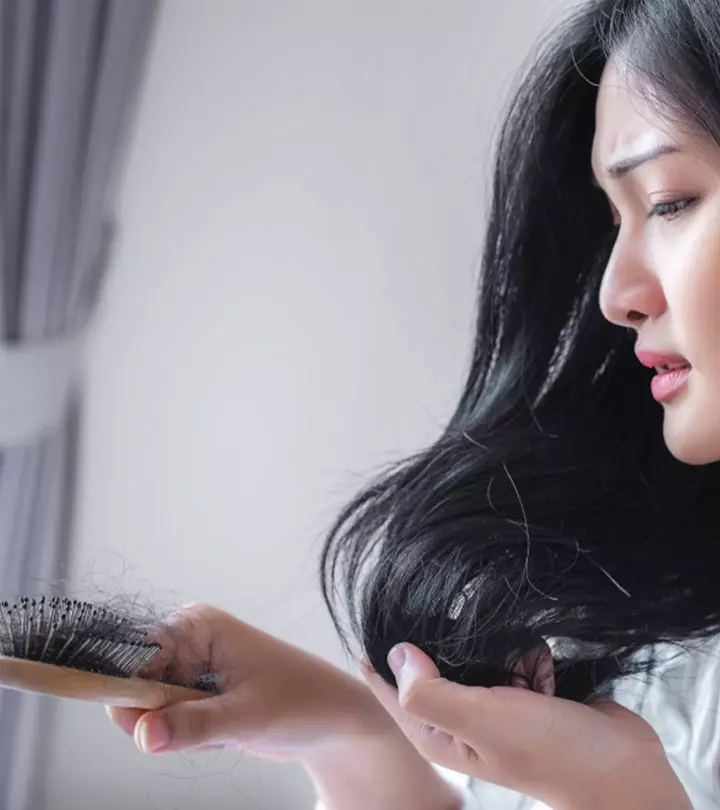
Image: Shutterstock
Common hair problems such as split ends, thinning, hair fall, and dandruff are being experienced by many of us. Everyone has a unique hair type and texture. Nowadays, due to pollution or other factors, no matter how much you care for your hair, you still face the same problems. Some simple and effective hair care tips get rid of such problems. Read this article to know more about other common hair problems and their treatment methods. Scroll down.
In This Article
Common Hair Problems And Their Treatments
1. Dandruff
Dandruff is a common scalp disorder characterized mainly by white flakes. It is also accompanied by an itchy scalp and inflammation (1). It is often caused by a dry scalp, excess sebum secretion, or sensitivity of your scalp to some hair care products. Having an overall dry skin type is the most apparent cause of dandruff. Dry skin causes white flakes, which, in turn, result in dandruff (2). Your scalp gets infected with the fungus Malassezia. This can make the scalp dry and flaky, thereby increasing the appearance of dandruff (3).
According to a review by the National Library of Medicine, seborrheic dermatitis is a common skin condition that affects approximately 3 to 10 out of 100 individuals. It exhibits a higher prevalence in men than women. Typically, individuals experience it for the first time during young adulthood or after the age of 50.
Several other internal and external factors can lead to the development of dandruff on your scalp. Contact dermatitis is triggered by certain hair care products and can irritate your scalp, which leads to flaking, itching, and dandruff. Seborrheic dermatitis usually affects areas that are rich in oil glands, and it causes inflammation, redness, and flaking (4). Furthermore, oil build-up flakes off your scalp as a result of not shampooing your hair regularly. Over secretion of certain male hormones can also result in dandruff.
Frequently scratching and brushing your scalp due to the itchiness caused by dandruff can damage the hair roots, which, in turn, result in hair loss. Also, dandruff causes hair loss if left untreated for a prolonged period. So, you should fix this problem quickly to avoid hair loss.
How To Fix It
- You can fix dandruff easily with some hair care products like anti-dandruff shampoos (5).
- Shampoos with ingredients like salicylic acid and ketoconazole can treat and prevent dandruff.
 Quick Tip
Quick Tip- Anecdotal evidence suggests that apple cider vinegar, baking soda, and fenugreek seeds help treat dandruff. You can apply hair masks made with these ingredients to get rid of dandruff.
2. Split Ends
A split end is the splitting of the hair shaft at the tip of your hair. There can be different types of split ends, based on the size and number of splits. These splits happen due to dryness or dehydration when the oils from the scalp do not reach the hair ends. The hair strands start to break at different points of your hair shaft. Detangling your hair aggressively, not conditioning your hair properly, and harsh environmental conditions can also lead to split ends. Improper hair care and some chemical treatments are other causes of split ends (5).
Furthermore, too much hair coloring, heat styling, bleaching, perming, and sun exposure can damage your hair. Once the hair ends split, nothing can be done. The ends must be cut off and extra care must be taken with conditioning. Split ends dont go away on their own, and trimming is the best way to get rid of them.
How To Fix It
- As the ends are drier, rubbing them with oil can provide nourishment and minimize split ends.
- Applying shampoo only near the scalp and conditioner from mid-lengths to the ends can prevent drying out the ends.
- To prevent more hair damage due to heat, start blow-drying your hair at low-temperature settings and use a wide-toothed comb to detangle it.
- Always use heat protectant while heat styling to avoid direct contact between your hair and the tool.
- You can repair and prevent split ends by using coconut oil, almond oil, coconut milk, and castor oil.
- Sleeping on a satin pillowcase and using microfiber towels may prevent split ends.
3. Hair Loss
It is normal to shed between 50 to 100 hair strands, according to the American Academy of Dermatology Association (6). If you notice excessive hair fall, exceeding these numbers, you might have a type of hair loss condition like androgenetic alopecia or telogen effluvium. Generally, at the end of the telogen phase in the hair growth cycle, the old hair falls out and is replaced by new hair. Other than this normal cycle, you can experience hair loss due to several factors like medication, stress, sudden weight gain or loss, genetics, and scalp infections. You can also observe baldness in men (male pattern baldness) with age due to changes in hormone levels.
Joey, a vlogger, shared about dealing with hair loss in a video. He offers some advice, stating, “If your hairline is receding to an advanced degree, it probably will look better when you shave it off, but do I care if you shave your hair off or not? No, so just make the decision based on what’s best for you. And funny enough, since shaving my head, I feel like I have actually gotten more confident, especially when meeting strangers and it’s totally a subconscious thing, because I don’t have to think about the fact that I have an incomplete hairline.” He also added, “I guess I can conclude from my hair loss journey that no one really thinks about you nearly as much as you think about yourself, not even close (i).”
A number of disorders can cause hair loss. People who are suffering from an autoimmune disease, alopecia areata, can lose hair on their scalp. Other factors like using birth control pills, chemotherapy, blood pressure medication, and antidepressants can cause hair loss. You can observe hair thinning in women due to hormonal imbalance with age. Also, major surgeries, fungal infections, pregnancy, and childbirth, as well as deficiencies of vitamin D, B12, and zinc, can contribute to hair loss. Certain hair care practices, such as wearing a tight ponytail or regularly bleaching or perming the hair, can also lead to hair loss. Poor diet is also one of the major reasons for hair loss (7).
How To Fix It
- Massage your scalp with hot oils, like coconut oil, almond oil, or olive oil. You can also add a few drops of castor oil to these carrier oils.
- Switch to a mild shampoo.
- Minimizing the usage of heat styling tools can reduce hair loss.
- Foods that are rich in proteins can prevent hair loss (7).
- If hair loss is due to any medicine, you can consult your doctor to discuss alternative medication.
- Hair loss due to male and female pattern baldness can be prevented with prescription medicines like minoxidil (to treat both men and women) and finasteride.
- In case of androgenic hair loss, women are prescribed anti-androgens that may reduce hair loss due to hormonal changes (8).
4. Premature Graying
The hair follicles contain melanin that gives the hair its color. With age, the hair can lose melanin, turning the strands silver or white. While this is common during old age, if you notice gray hair in your early 20s and 30s, it is known as premature graying. Genetics play a huge role in premature graying (9). If your parents had gray hair at an early age, chances are high that you will also experience premature graying.
Stress is another important factor that can trigger graying of hair at an early age (10). Vitamin and mineral deficiencies, chemicals, melanin deficiency, heat styling, and certain medical conditions can result in premature graying (7), (11). Furthermore, a build-up of hydrogen peroxide in the follicles is a possible cause of this disruption in melanin production (12). There is no permanent solution for premature graying of hair. But with regular hair care and following some remedies, you can slow down the process.
How To Fix It
- If you want to cover your gray hair, color it with semi- or demi-permanent hair dye. These dyes are less harsh than permanent hair dyes and contain fewer chemicals.
- Reducing your stress levels, less usage of heat styling tools, massaging your scalp with oil, and intake of a balanced diet can also prevent premature graying.
5. Frizzy Hair
Frizz refers to the strands of dry hair that stick out from the rest of your hair. This is due to the loss of moisture from the hair. Moisture loss damages the hair cuticles and hair shaft, while the heat from styling tools can damage the keratin layer. Frizz is also a result of a lack of a good hair care regimen. Frequent use of styling tools, chemicals, UV rays, constant dehydration, genetics, and humidity can cause frizzy hair.
How To Fix It
- Hair masks with natural ingredients that can help add moisture back into your hair are essential for fighting frizz.
- Leave-in conditioners and hair serums also helps in dealing with frizzy hair.
- Use a shampoo and conditioner set that is specially formulated for frizz control.
- If you want to blow-dry, your hair apply heat protectant prior to the process and use a boar bristle brush to avoid damage.
- Avoiding over-shampooing and bleaching your hair.
- Regular trimming and covering your hair with a scarf or hat can prevent frizzy hair.
- Loose braids and using microfiber towels can keep your hair healthy and frizz-free.
 Quick Tip
Quick Tip6. Damaged Hair
Is your hair looking dull, dry, and frizzy with split ends? These are all signs of damaged hair. Many things like heat styling, your hair grooming habits, perming, bleaching, chemicals, and environmental factors can wreak havoc on your hair. Damaged hair develops cracks in the outer layer of the hair shaft, which makes your hair difficult to manage.
Hair needs moisture, and lack of moisture can make your hair dry and brittle. Hair dyes that contain hydrogen peroxide open the cuticle and affect the hair structure. Frequent use of heat styling tools can also fry your hair. Furthermore, improper diet, wrong hair care practices, and stress are the other major causes of damaged hair. However, you can repair your damaged hair by providing nourishment and moisture in the form of hair masks. Scroll down to know more about damaged hair treatment options.
How To Fix It
- Provide essential moisture in the form of hair masks containing egg, olive oil, and avocado to your damaged hair (13), (14).
- You need to minimize the usage of heat styling tools as much as possible to avoid hair damage.
- It is necessary to follow a nutrient-rich diet that can make your hair healthy.
- Trim your damaged ends (split ends) every 3 weeks.
- Start using a deep conditioner that can soften your hair.
- Don’t wash your hair daily, and use a mild sulfate-free shampoo.
- Give your hair a break between hair treatments like hair coloring and perming.
7. Dry Hair
Hair that lacks natural oil looks rough and is termed as dry hair. Lack of moisture in the scalp causes dry flakes. Dry hair is brittle, appears dull, and is prone to more tangles. Frequent shampooing, over-coloring, perming, and excessive heat styling can cause dry hair. Over-washing your hair with shampoos can strip away natural oils from your scalp and make your hair dry. Also, the use of chlorinated or hard water and vitamin deficiencies result in dry hair.
How To Fix It
- Scalp massage with hot hair oils can enhance blood circulation and provide essential moisture and nourishment to your hair.
- Deep conditioning hair masks can help in dealing with dry hair.
- A gentle shampoo and hair care products with essential proteins and minerals can also help replenish dry hair.
- Intake of a nutrient-rich diet, using chemical-free products, and minimizing the usage of heat styling tools can prevent dry hair issues.
8. Greasy Hair
Excess sebum can make your hair oily. Sebum is produced by the sebaceous glands that nourish and protect your hair. However, sometimes these glands produce extra oil, which can lead to greasy hair. Over-washing of hair can lead to excess oil production. Sebaceous glands produce more oils to compensate for the natural oil that shampooing strips off. This condition results in greasy hair. The accumulation of dirt due to oiliness causes dandruff and itchiness, which, in turn, results in hair fall.
Furthermore, hormonal imbalances, humidity, junk food, frequent brushing of hair, genetics, excess product build-up, and over-conditioning of your hair are the other reasons for greasy hair.
How To Fix It
- Avoid washing your hair daily. Limit it to twice or thrice a week.
- Switch to clarifying shampoos as they wash out the excess oil and product build-up from the hair.
- The intake of healthy food like green veggies and a nutrient-rich diet, avoiding excess hair styling, and rinsing your hair with cold water can solve your greasy hair problem.
9. Hair Breakage
Generally, hair breaks when it is dry and brittle. Each hair strand has overlapping scales, and when these scales become weak, your hair becomes prone to breakage. If you are experiencing hair breakage, you can observe short hair strands, rough texture, split ends, and brittle hair.
Dryness is the primary cause of hair breakage. Over-processing your hair with chemicals, colors, bleach, harsh brushing, aggressive drying techniques, eating disorders, and heat styling are other causes of hair breakage.
How To Fix It
- Always comb your hair gently with a wide-toothed comb.
- Massage your scalp with hot hair oils that stimulate blood circulation and provide nourishment to the hair.
- Condition your hair every time your wash it.
- Dont blow-dry your hair on a high heat setting.
- Getting regular trims will eliminate split ends and reduce hair breakage.
10. Hair Thinning
Is your hair losing its volume and thickness? While it is normal to experience some hair shedding daily, excessive hair loss could be a sign of hair thinning, resulting in baldness or androgenetic alopecia. Medical conditions, hormonal imbalances, stress, pregnancy, genetics, and sudden weight loss can cause hair thinning (15), (16), (17), (18). Autoimmune disorders like alopecia areata can also trigger hair loss (19).
Furthermore, tight hairstyles, excess production of the dihydrotestosterone (DHT) hormone, and poor diet can result in hair thinning.
How To Fix It
- Consult your doctor to identify the root cause of your hair thinning problem and treat it.
- Do scalp massages with hot oils regularly. They stabilize the hair loss and may help in hair regrowth (20).
- Taking vitamin supplements and topical application of minoxidil can promote hair growth (21).
11. Oily Scalp
An oily scalp is a prevalent hair issue triggered by excessive sebum production from the scalp’s oil glands. This surplus oiliness often results in greasy, weighed-down hair and can stem from various factors, such as hormonal fluctuations, genetics, or an overactive sebaceous gland.
How To Fix It
- Opt for a gentle, clarifying shampoo designed explicitly for oily hair types to effectively cleanse away excess oil without stripping the scalp of its natural moisture.
- Limit washing your hair to 2-3 times a week to prevent stimulating more oil production.
- Use a balancing conditioner solely on the hair ends to maintain moisture while avoiding excessive oiliness on the scalp.
- Avoid heavy styling products and opt for lightweight, oil-free formulations.
- Use a dry shampoo between washes to absorb excess oil and add volume to your tresses.
Most of us experience some common hair problems like thinning, split ends, hair fall, and dandruff. These problems may vary from person to person, but following the tips mentioned above can help you minimize these issues. Switching to chemical-free hair care products, reducing the use of heat styling tools, following a proper hair care regimen, and including nutrient-rich foods in your diet helps solve many hair care issues. Everyone does not have the same hair type and texture. So, the method that suits you may not suit the other. Therefore, be consistent and experiment with products until you find the one that suits your hair.
Key Takeaways
- You can use a shampoo containing salicylic acid and ketoconazole to treat dandruff.
- Split ends can be managed by rubbing some coconut oil into the ends of your hair and using low temperatures when heat styling your tresses.
- Loss of moisture from the hair triggers frizzy hair. Hair masks, conditioners, and regular trimming can manage frizzy hair effectively.
Frequently Asked Questions
Which lack of vitamin causes hair fall?
A deficiency of vitamins D and B12 may lead to hair loss.
What are hair infections?
When microbes like fungi and bacteria infest your scalp, it leads to scalp infections that impact hair health and growth. Some common hair and scalp infections include folliculitis, seborrheic dermatitis, and dandruff.
A woman usually starts losing her hair after the age of thirty. But hair loss can be due to various reasons, as explained in the following video. Check it out.
Personal Experience: Source
StyleCraze's articles are interwoven with authentic personal narratives that provide depth and resonance to our content. Below are the sources of the personal accounts referenced in this article.
(i) How rapid hair loss changed my lifehttps://www.youtube.com/watch?v=qBa-geRTVwE
References
Articles on StyleCraze are backed by verified information from peer-reviewed and academic research papers, reputed organizations, research institutions, and medical associations to ensure accuracy and relevance. Read our editorial policy to learn more.
- DANDRUFF: THE MOST COMMERCIALLY EXPLOITED SKIN DISEASE,
https://www.ncbi.nlm.nih.gov/pmc/articles/PMC2887514/ - A New Postulate on Two Stages of Dandruff: A Clinical Perspective,
https://www.ncbi.nlm.nih.gov/pmc/articles/PMC3129121/ - MalasseziaCan it be Ignored?,
https://www.ncbi.nlm.nih.gov/pmc/articles/PMC4533528/ - Adult Seborrheic Dermatitis,
https://www.ncbi.nlm.nih.gov/pmc/articles/PMC3100109/ - Hair Cosmetics: An Overview,
https://www.ncbi.nlm.nih.gov/pmc/articles/PMC4387693/ - Do You Have Hair Loss Or Hair Shedding?,
https://www.aad.org/public/diseases/hair-loss/insider/shedding - The Role of Vitamins and Minerals in Hair Loss: A Review,
https://www.ncbi.nlm.nih.gov/pmc/articles/PMC6380979/ - Impact of Testosterone on Hair and Skin,
https://www.longdom.org/open-access/impact-of-testosterone-on-hair-and-skin-2161-1017-1000187.pdf - Premature Graying of Hair: Review with Updates,
https://www.ncbi.nlm.nih.gov/pmc/articles/PMC6290285/ - Oxidative stress in ageing of hair,
https://pubmed.ncbi.nlm.nih.gov/20805969/ - Epidemiological and Investigative Study of Premature Graying of Hair in Higher Secondary and Pre-University School Children,
https://www.ncbi.nlm.nih.gov/pmc/articles/PMC3746220/ - Senile hair graying: H2O2-mediated oxidative stress affects human hair color by blunting methionine sulfoxide repair,
https://pubmed.ncbi.nlm.nih.gov/19237503/ - Naturally Occurring Hair Growth Peptide: Water-Soluble Chicken Egg Yolk Peptides Stimulate Hair Growth Through Induction of Vascular Endothelial Growth Factor Production,
https://pubmed.ncbi.nlm.nih.gov/29583066/ - Topical Application of Oleuropein Induces Anagen Hair Growth in Telogen Mouse Skin,
https://www.ncbi.nlm.nih.gov/pmc/articles/PMC4462586/ - Diet and hair loss: effects of nutrient deficiency and supplement use,
https://www.ncbi.nlm.nih.gov/pmc/articles/PMC5315033/ - Burden of Hair Loss: Stress and the Underestimated Psychosocial Impact of Telogen Effluvium and Androgenetic Alopecia,
https://www.sciencedirect.com/science/article/pii/S0022202X15309635 - Pregnancy and the hair growth cycle: anagen induction against hair growth disruption using Nourkrin® with Marilex®, a proteoglycan replacement therapy,
https://onlinelibrary.wiley.com/doi/abs/10.1111/jocd.12286 - Female Pattern Hair Loss,
https://www.ncbi.nlm.nih.gov/pmc/articles/PMC3968982/ - Alopecia Areata: A tissue specific autoimmune disease of the hair follicle,
https://www.sciencedirect.com/science/article/abs/pii/S1568997205001187 - Standardized Scalp Massage Results in Increased Hair Thickness by Inducing Stretching Forces to Dermal Papilla Cells in the Subcutaneous Tissue,
https://www.ncbi.nlm.nih.gov/pmc/articles/PMC4740347/ - Minoxidil: mechanisms of action on hair growth,
https://onlinelibrary.wiley.com/doi/abs/10.1111/j.1365-2133.2004.05785.x
Read full bio of Dr. Shruti Chavan
Read full bio of Arshiya Syeda
Read full bio of Anjali Sayee
Read full bio of Monomita Chakraborty





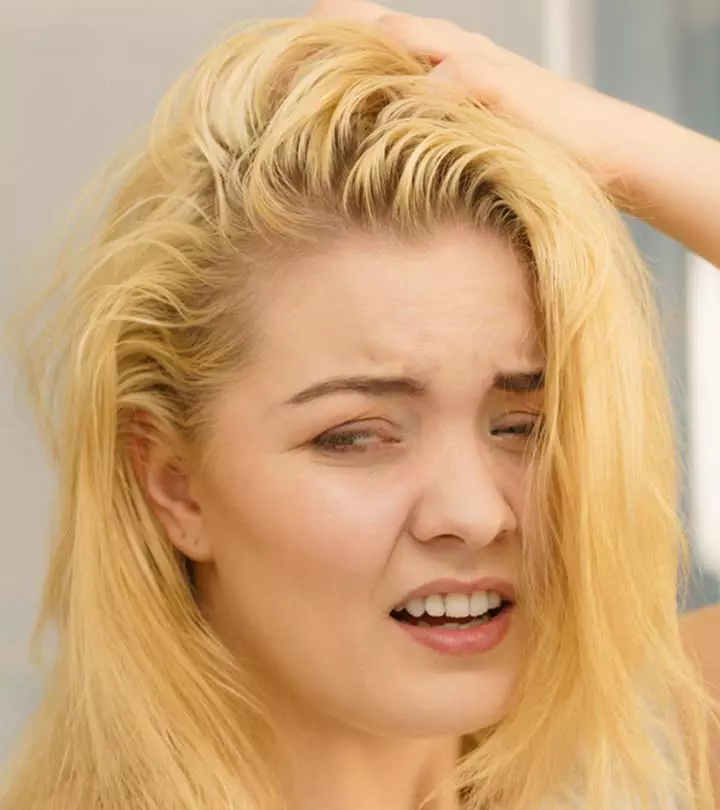

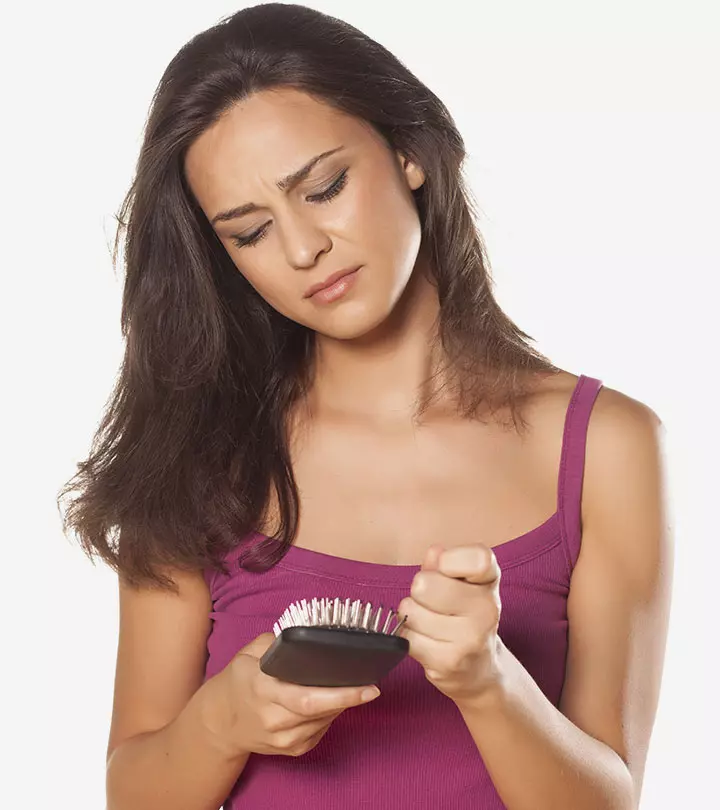
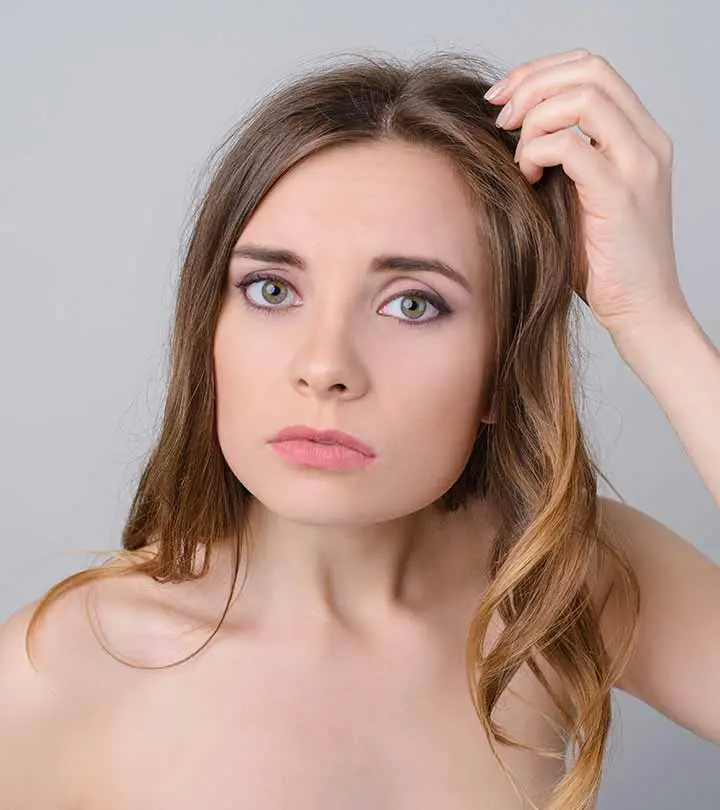
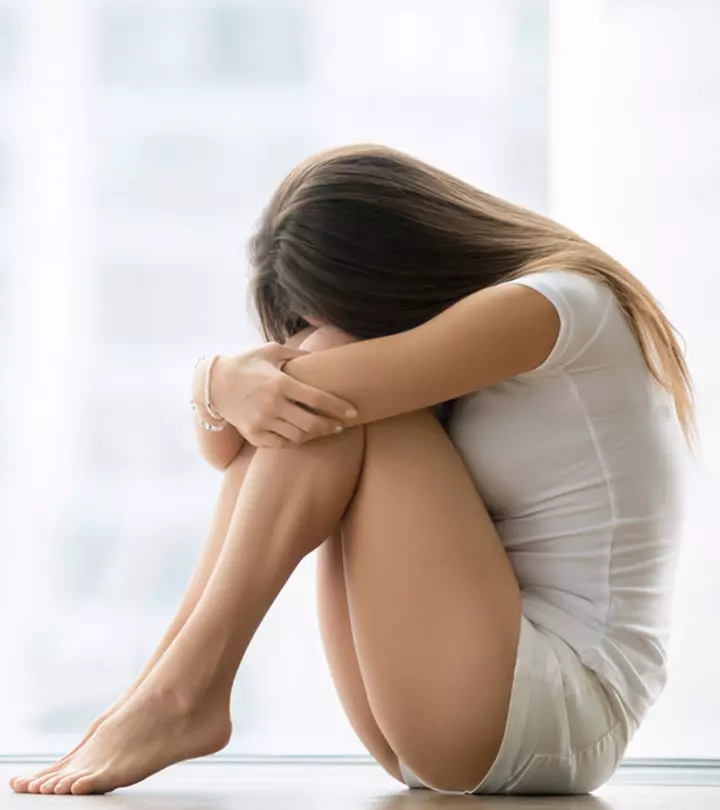

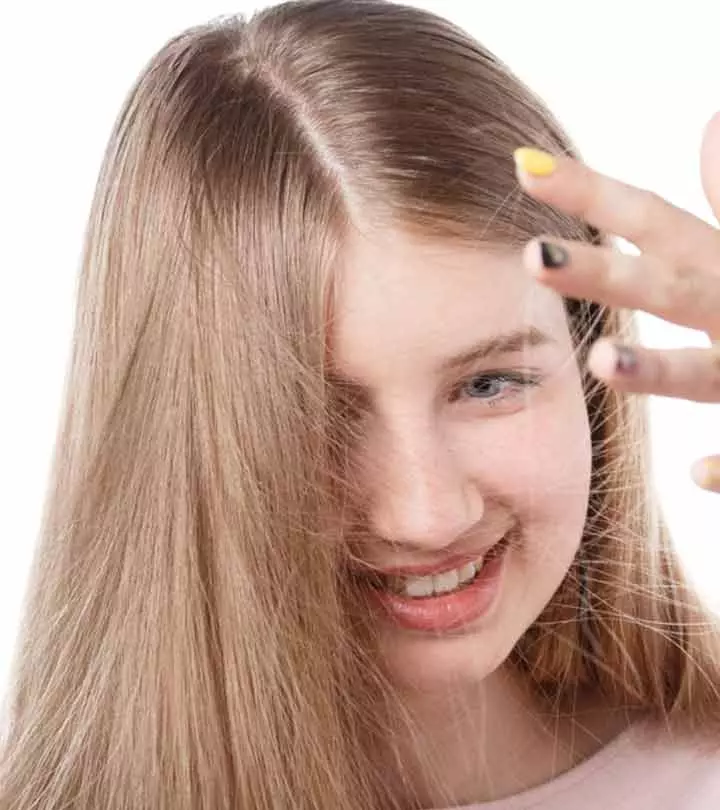

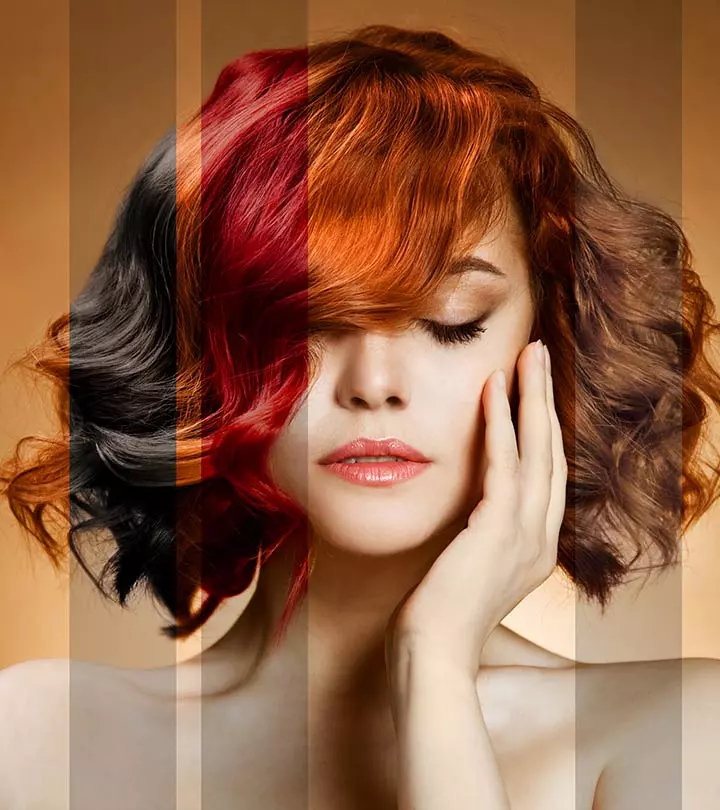
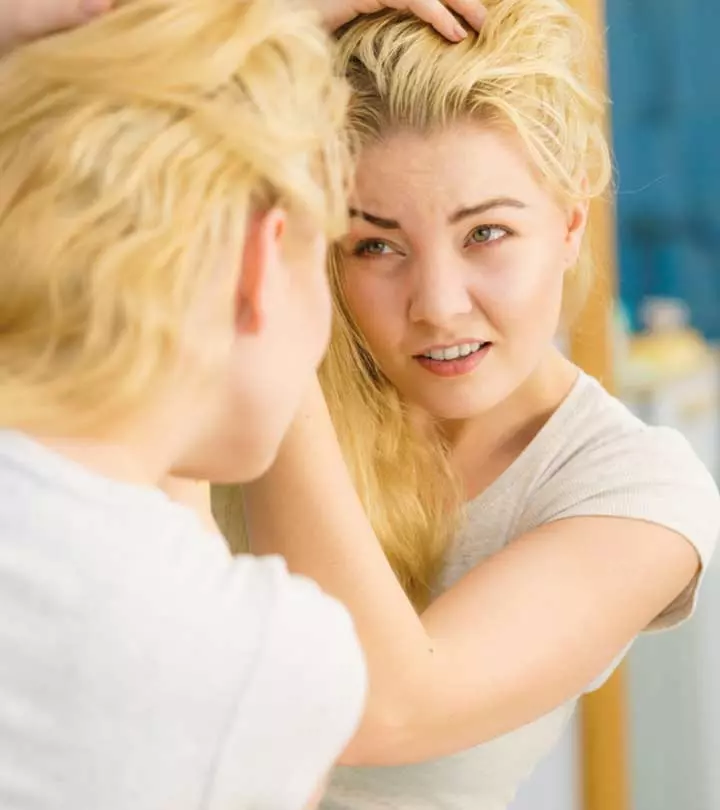


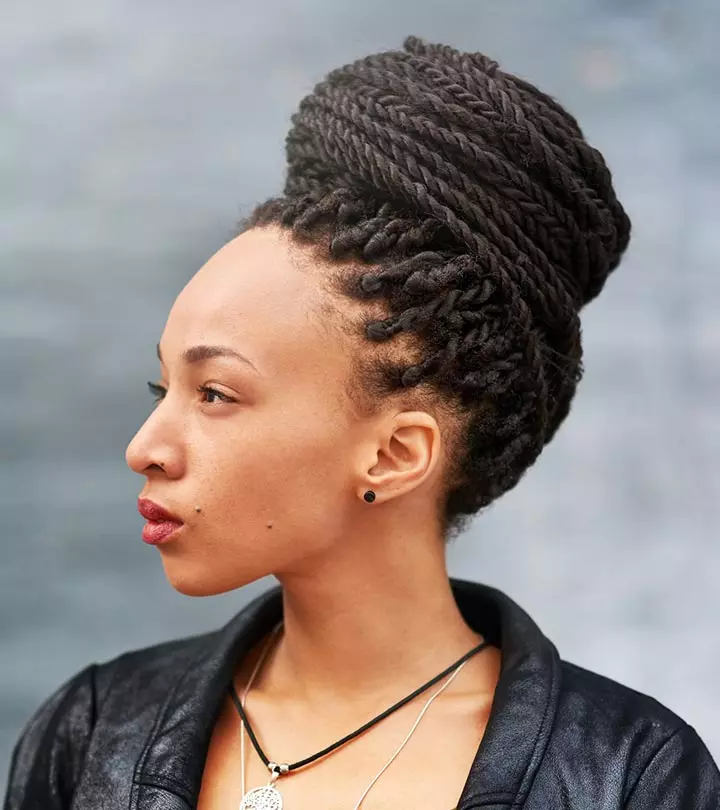
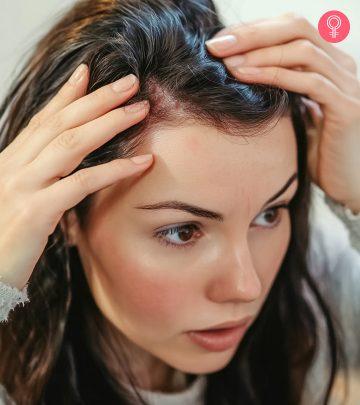
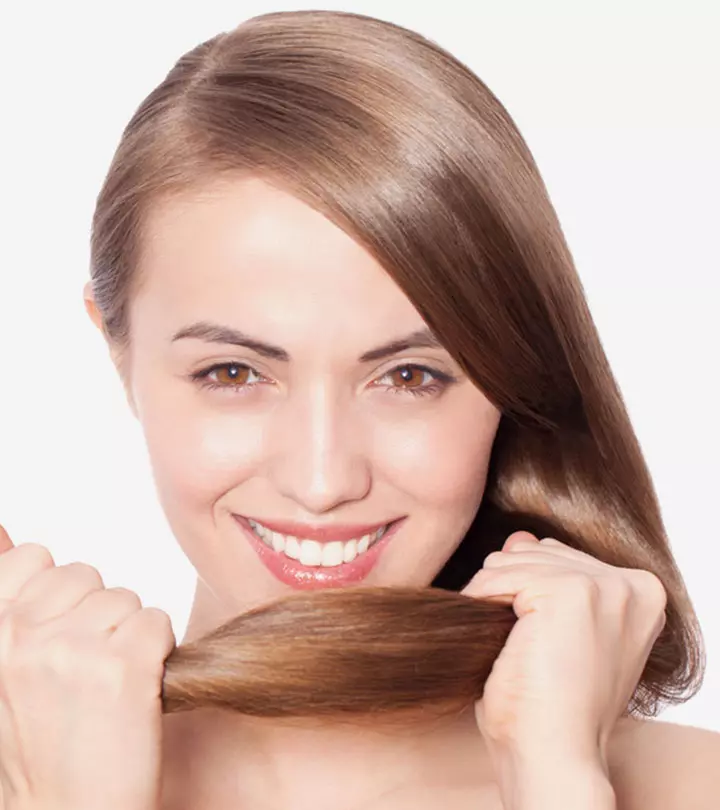
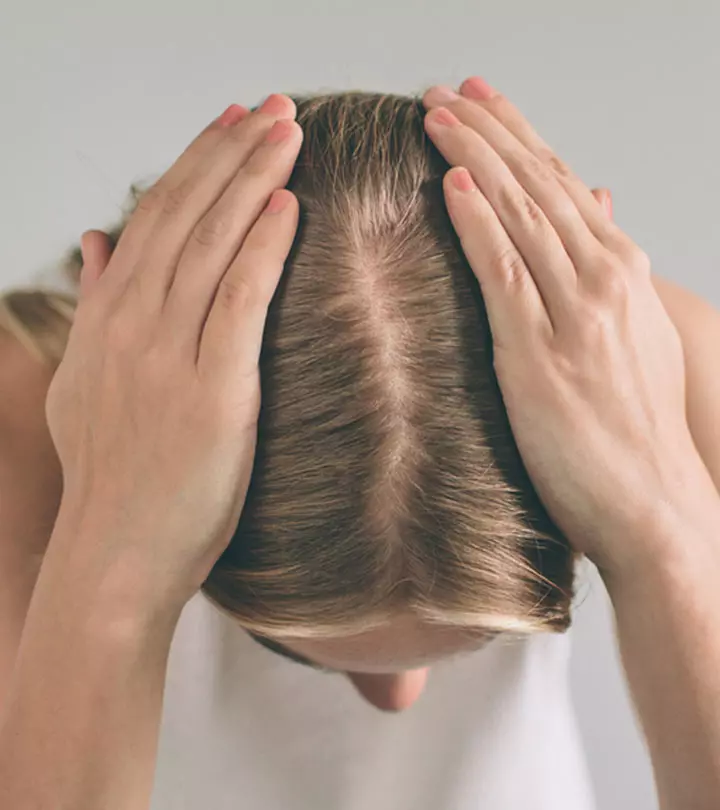
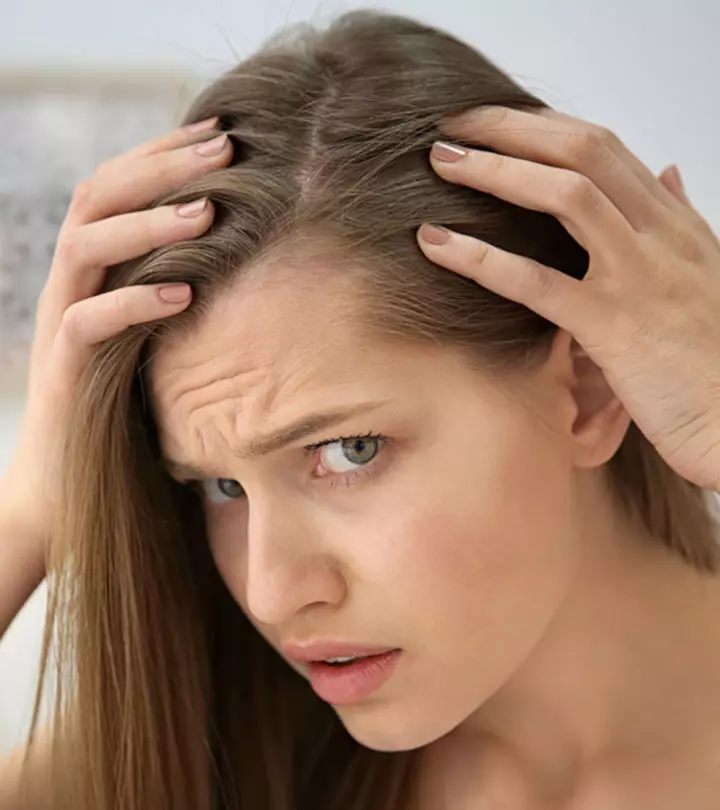



Community Experiences
Join the conversation and become a part of our empowering community! Share your stories, experiences, and insights to connect with other beauty, lifestyle, and health enthusiasts.